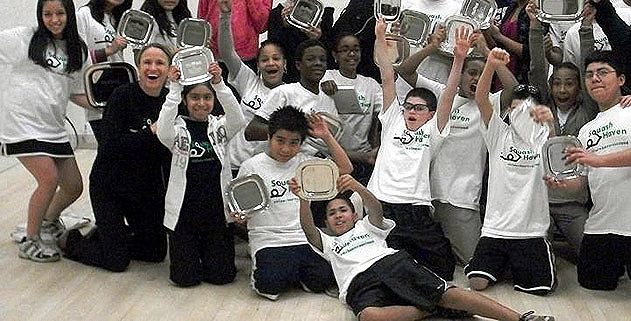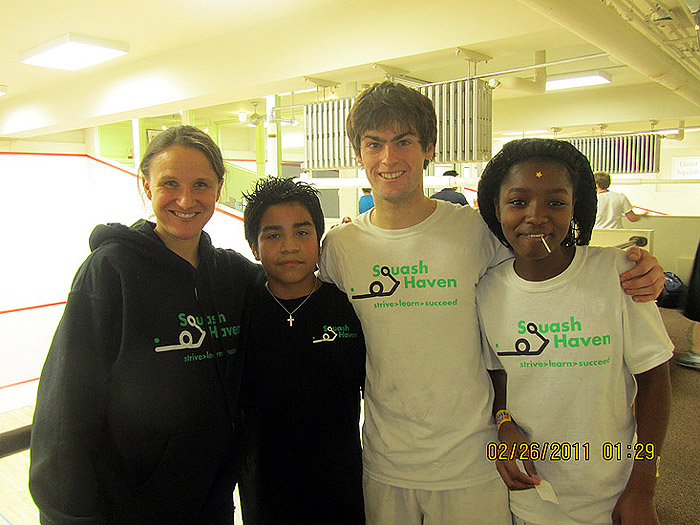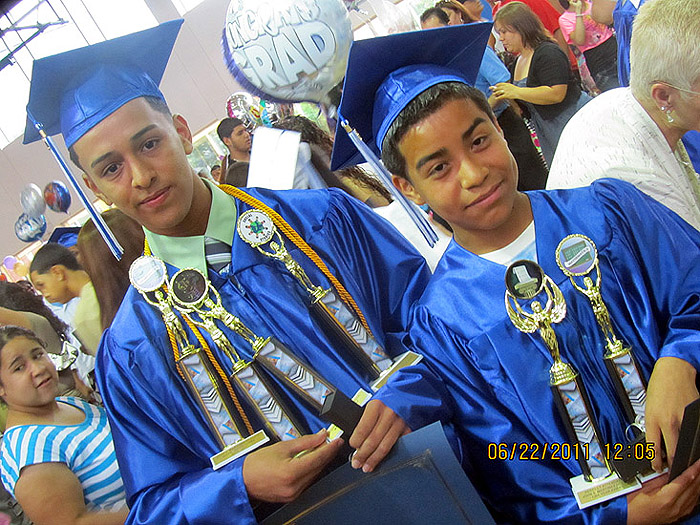An Interview With Squash Haven Executive Director Julie Greenwood
by Rob Dinerman for DailySquashReport.com

Published August 3, 2011
Dinerman: You were a highly successful athlete at Williams College in the mid-1990’s in both tennis and squash, and later coached varsity teams at Williams in both sports during the early-2000’s. Was there any reason that you chose squash rather than tennis as the sport that is linked with the youth-enrichment effort that Squash Haven focuses upon?
JG: I grew up playing at the Arthur Ashe Youth Tennis Center in Philadelphia so always had an interest in the potential for athletics to promote positive youth development and increase educational opportunity. I would say that my interest in coaching has always, however, been driven more by an interest in personal development than by the particular sports I have coached and played.
I do, however, think that there are several characteristics of the game of squash and the urban squash model that made the opportunity to come to Squash Haven particularly compelling. Squash is played at most of our country’s top colleges and universities, and our students make explicit connections to academically rigorous high school and college environments from their first days in the program. I was particularly drawn to the strength of Squash Haven’s relationship to Yale and the Yale teams given my background in higher education.
I also believe that the size of the game in the States enables us to build relationships and access opportunities that would be much more difficult in a bigger sport. I always use the example of Natalie Grainger being on our Board. Our kids get on court with her every year. In what other sport could we offer that kind of exposure?
Most importantly, urban squash is deliberately small. Greg Zaff has developed a model that works… comprehensive academic, athletic, and personal support for a small number of kids over a long period of time. It is not glamorous, but the continuous high expectations we hold for our team members start to multiply over time and begin to affect remarkable change.
Dinerman: By the time you arrived in New Haven as the first Executive Director at Squash Haven in 2007, this type of squash/youth-enrichment organization had been around since Greg Zaff started SquashBusters in Boston in 1996. Did you study what had happened during that first decade and were there any major differences between whatever expectation you might have had and your actual experience?
JG: I pretty much jumped right in. Everything I did was a product of a combination of research and practice, which makes more sense to me than planning for the hypothetical. I was running tryouts while I was still at Williams and we started in September when I moved to New Haven in July. I had the benefit of the incredible example already set by other programs as well as the culture of information sharing and support that existed among the member programs. All of the then-Executive Directors (Greg Zaff, George Polsky, Tim Wyant, and Steve Gregg) made themselves available whenever I needed anything. I also owe a debt of gratitude to my founding board, which set up a lot of the initial funding and filings so that I would walk right in and focus my initial energy on building a quality program.
I will say that one of the most comforting and empowering things for me at the beginning was that I had the example of the other programs to consult as well as the freedom to build a program that made the most sense for New Haven and our kids.
Dinerman: Has the model changed in any way during your four years at the Squash Haven helm? If so, in what way, and are there any philosophical changes that you feel SHOULD be made?
JG: I am proud of the fact that I have built a culture at Squash Haven where my staff and I are always thinking about ways we can improve our effectiveness. Most of the time, this takes the form of small daily tweaks but there have been several significant areas of change since the program’s initial days.
I spent much of the 2009-10 year working on a strategic plan that was unanimously approved by the Board in June 2010. The major areas of change we focused on coming out of the plan included: a commitment to improving the recruitment and selection processes; an increase in the number of partner schools we draw kids from; clarified standards for program dismissal; and a commitment to doubling our program size by 2015 to serve 100 students in grades 4-12.
The changes in recruitment, selection, and standards for dismissal were driven by asking difficult questions about the kinds of students we are best suited to serve. We defined those students clearly, and then we built our process around finding them. Because of the small number of students we serve and the intensity of our commitment over time, this piece is critical. Our students are motivated, committed, and eager to take advantage of the opportunities we can afford.
At this point, we couldn’t be happier with the way things are going. We nailed the objectives coming out of the strategic plan this year and look forward to continued success. It feels incredible to be moving away from start-up-like exploration and towards deliberate organizational building around universally agreed upon goals.
Dinerman: Where did you grow up and go to high school, what other sports did you play during those formative years, and at what stage, and why, did you decide to zero in on racquet sports, as you clearly had done by the time you arrived at Williams?
JG: I grew up in Wayne, PA and am actually a rather unlikely racquet sports devotee. I went to a public high school and didn’t go to a country club so I didn’t really have access to squash.
I actually played a lot of sports growing up. In high school, I was a three-sport athlete in tennis, diving, and softball. I also grew up in a paddle tennis family and played a lot of tournament paddle in my high school years. I only got serious about tennis my sophomore year, when I went to the state tournament. I started playing tournaments and quickly moved to a place where playing was a consideration in my college search. When I chose Williams, I just had this feeling that I would learn squash. Gail Ramsay was the coach at the time and several other tennis players would take up the game with her support. I started freshman year, just as the game was transitioning to softball. It was a pretty sweet moment for a tennis player with a good lob serve, volleys, and hands to do pretty well. Gail was incredibly generous with her coaching time, and invested a lot in my development even after she went to Princeton. I owe her a huge debt of gratitude.
I often reflect on just how much my decision to go to Williams has affected my life, much more so than the average college graduate. I probably wouldn’t have learned squash and I would never have gotten into coaching. I am very grateful.
Dinerman: Your senior year in college culminated with your receiving the Purple Key Award, given annually to the outstanding graduating male and female athlete. What was your squash background prior to entering Williams and which coaches had the biggest impact on you?
JG: The only coach I ever had was Gail and then a woman by the name of Erin Robson. My debt of gratitude to Gail is enormous, and to be perfectly honest I was just in the right place at the right time in terms of the game creating so many opportunities for me.
Dinerman: You have spent six summers leading trips, including two cross-country bike trips for middle and high school students. We’d be interested to hear about those trips and what influence, if any, they may be having on your approach to your work at Squash Haven.
JG: When I graduated from Williams, I was really ready to try some new things. As a year-round competitive athlete, I hadn’t studied abroad or gotten into the many incredible offerings of the outing club at Williams. I was curious about travel, work with kids, and getting into the outdoors. The company I worked for was based in Williamstown and hired athletic types like me, assuming that we would have good leadership skills.
For me, it was an incredible opportunity to travel but more importantly to get some of the best hands-on instruction, then paired with experience, about working with kids and building a positive, strong, and participatory team dynamic. We went through rigorous leader training and learned a lot about creating structure and rules. In my experiences as a leader, I learned that in working with kids I would reap the benefits of the structures I create. More so probably even than college coaching, those lessons have been directly applicable to my work here. A lot of the work I do with kids is intuitive, but not all of it.
Dinerman: What relationship does Squash Haven have with Yale and to what degree, if any, do members of the Yale varsity squash teams play a role in Squash Haven?
JG: We are very fortunate to have a very happy home here at Yale. Yale has signed a second licensing agreement with us that guarantees free office space and access to courts and classrooms through 2015. We are our own non-profit, so we are responsible for our own fundraising.
Dave Talbott and Senior Associate Athletic Director Tim Ford are on our Board and Dave has, from the program’s early days, made a formal commitment on the part of his men’s and women’s teams to have each team member participate in coaching our kids once a week. We have a huge number of Yale community members who volunteer as coaches, tutors, and mentors – about 60 last year. Those include undergraduates, professors, and graduate students. Our undergraduate volunteers have even started a Dwight Hall group.
The opportunity to build a program out of a world-class facility at a world-class educational institution with world-class players and students working with our kids is, in my mind, unparalleled. I love higher education and was very reluctant to leave it, so the association with Yale and its teams was one of the powerful pulls in accepting this position.
Dinerman: Is placement of Squash Haven student/athletes into New England prep schools a priority? If so, how has that transition been going for them?
JG: One of the objectives of the strategic plan was to explore the possibility of students applying to prep schools. We did that very successfully this year, and in the fall we will be sending four students to boarding schools with over $172,000 in financial aid. It is very powerful to see such a concrete step for them in life opportunities, and to know that we have helped make that possible.
They will leave in the fall, and we will know a lot more about the transition then, but we have done our best to prepare them. They have been in summer school this summer at a local independent school, and are keeping up with their games. We also recently had a meeting to go over packing lists and expectations for our ongoing relationship. We invited Senior Associate Director of Admission at Choate Colin Lord to come down and speak to kids and parents about preparing for the transition and things they might face culturally, academically, and socially.
While we will be sending some kids away, it is really part of a more overarching goal of connecting motivated kids and families to the best educational, athletic, and life opportunities possible. I went to public school and don’t have some sort of belief that kids need to go to prep school. I do, however, powerfully believe in the transformative influence of strong educational communities. I see boarding school as a way to give our kids the kinds of environment we give them all the time.
Dinerman: How has your prior work with the Greylock ABC (A Better Chance) program influenced your approach at Squash Haven?
JG: While this is by far the most intensive work with urban youth that I have done, I have a longstanding interest in urban education. Living in Williamstown for so long, it was understandably difficult to pursue, and the local ABC program was a way I could get involved with urban kids in a rural environment trying to make sense of the high school opportunity they had chosen. I wouldn’t say it influenced a whole lot here, but was just a way I was able to explore my interest in working with urban kids while in Williamstown.
Dinerman: Tell us about your experience working in Brooklyn with former inmates as part of the Ready, Willing and Able Program.
JG: My work at Ready, Willing, and Able was one of the coolest experiences I have had. As I was starting to think about leaving Williamstown, I spent a summer living in Brooklyn. I was ready for a more urban and diverse experience, and I really wanted to sink my teeth into issues of urban poverty. I ended up finding R, W, and A and committing two days a week throughout the summer preparing recently incarcerated men for the GED. I absolutely loved everything about the experience. Walking through the streets of Bed-Stuy on the way to work encouraged powerful questions about race, privilege, and experience. I loved the men I worked with and found them smart, capable, and courageous. My star pupil, Anthony Flagg, was asked to go to a city-wide reception with the mayor at Gracie Mansion. I accompanied him and it was an incredibly proud moment for me.
Dinerman: You have lived in a number of places in the US, from your time in New England to California, where you earned a Masters in Education at Stanford in 2003. Where have you enjoyed living the most?
JG: I feel really fortunate to have lived in some incredible places, all of which have also been home to very formative educational and work opportunities. I wouldn’t trade any experience and each place has felt like exactly where I wanted to be at that time in my life. In general, the aspects of a place that are most important to building a happy existence for me are: an easy, non-car commute; easy access to community-building activities; and a lot of people who are invested in place.
New Haven is a very well-kept secret. I love it, everything about it, even its problems. I bike to work, I have a great apartment that is walk-able to downtown but also has a great backyard. There are great parks for running and biking and great communities for sharing both activities. Above all, the people who choose to make this place their home are invested in its success. I love the diversity of the people I have met and most of all I love our kids and families.
Dinerman: The National Urban Squash and Education Association (NUSEA) was founded in 2005 in response to the growing number of squash/youth-enrichment organizations that were taking root all over the country. How closely do these organizations interact with each other and are there any ways in which you have incorporated something that seems to have worked elsewhere into Squash Haven?
I would say, somewhat repetitively, that there is a wonderful blend of autonomy and support in the urban squash world. At our cores, we all are about providing educational, athletic, and personal support for urban kids in sustained, relationship-driven ways. What that looks like in a day to day context, however, is far different. I have immeasurable respect for my colleagues in urban squash and I know that if there is a question or problem I can call them at any time.




Back To Main
